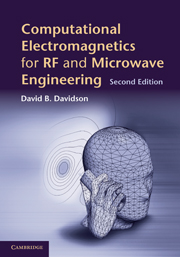Book contents
- Frontmatter
- Dedication
- Contents
- Preface to the second edition
- Preface to the first edition
- Acknowledgements
- To the reader
- List of notation
- 1 An overview of computational electromagnetics for RF and microwave applications
- 2 The finite difference time domain method: a one-dimensional introduction
- 3 The finite difference time domain method in two and three dimensions
- 4 A one-dimensional introduction to the method of moments: modelling thin wires and infinite cylinders
- 5 The application of the FEKO and NEC-2 codes to thin-wire antenna modelling
- 6 The method of moments for surface modelling
- 7 The method of moments and stratified media: theory
- 8 The method of moments and stratified media: practical applications of a commercial code
- 9 A one-dimensional introduction to the finite element method
- 10 The finite element method in two dimensions: scalar and vector elements
- 11 The finite element method in three dimensions
- 12 A selection of more advanced topics in full-wave computational electromagnetics
- Appendix A The Whitney element
- Appendix B The Newmark-β time-stepping algorithm References
- Appendix C On the convergence of the MoM Reference
- Appendix D Useful formulas for simplex coordinates
- Appendix E Web resources
- Appendix F MATLAB files supporting this text
- Index
- References
5 - The application of the FEKO and NEC-2 codes to thin-wire antenna modelling
Published online by Cambridge University Press: 05 July 2014
- Frontmatter
- Dedication
- Contents
- Preface to the second edition
- Preface to the first edition
- Acknowledgements
- To the reader
- List of notation
- 1 An overview of computational electromagnetics for RF and microwave applications
- 2 The finite difference time domain method: a one-dimensional introduction
- 3 The finite difference time domain method in two and three dimensions
- 4 A one-dimensional introduction to the method of moments: modelling thin wires and infinite cylinders
- 5 The application of the FEKO and NEC-2 codes to thin-wire antenna modelling
- 6 The method of moments for surface modelling
- 7 The method of moments and stratified media: theory
- 8 The method of moments and stratified media: practical applications of a commercial code
- 9 A one-dimensional introduction to the finite element method
- 10 The finite element method in two dimensions: scalar and vector elements
- 11 The finite element method in three dimensions
- 12 A selection of more advanced topics in full-wave computational electromagnetics
- Appendix A The Whitney element
- Appendix B The Newmark-β time-stepping algorithm References
- Appendix C On the convergence of the MoM Reference
- Appendix D Useful formulas for simplex coordinates
- Appendix E Web resources
- Appendix F MATLAB files supporting this text
- Index
- References
Summary
Introduction
With the theoretical background now established, one is in a position to start using commercial and public domain MoM programs intelligently. In this chapter, we will discuss primarily the application of the commercial code FEKO for antenna modelling, but will also discuss the use of the public domain code NEC-2 in this regard. Other than FEKO, few commercial programs (other than some proprietary NEC-2 extensions) provide good support for modelling thin-wire antennas, the topic of this chapter; such antennas are still very widely used indeed. For commercial programs, material is usually available to assist novice users to get started with the codes. Hence we will not describe the basic concepts of entering the geometry of the problem, including the source, and specifying parameters such as operating frequency and radiation patterns, since these vary from program to program, indeed quite often from release to release, and are usually quite well documented by the suppliers. However, in the case of NEC-2, some comments are in order.
NEC-2 is a “card driven” program, dating back to the days of “decks” of punched cards. A NEC model is described by a geometry file, usually with a .nec extension. An example is given in Fig. 5.1. If using NEC in this form, one must obtain a copy of the user manual [1].
- Type
- Chapter
- Information
- Computational Electromagnetics for RF and Microwave Engineering , pp. 166 - 200Publisher: Cambridge University PressPrint publication year: 2010



